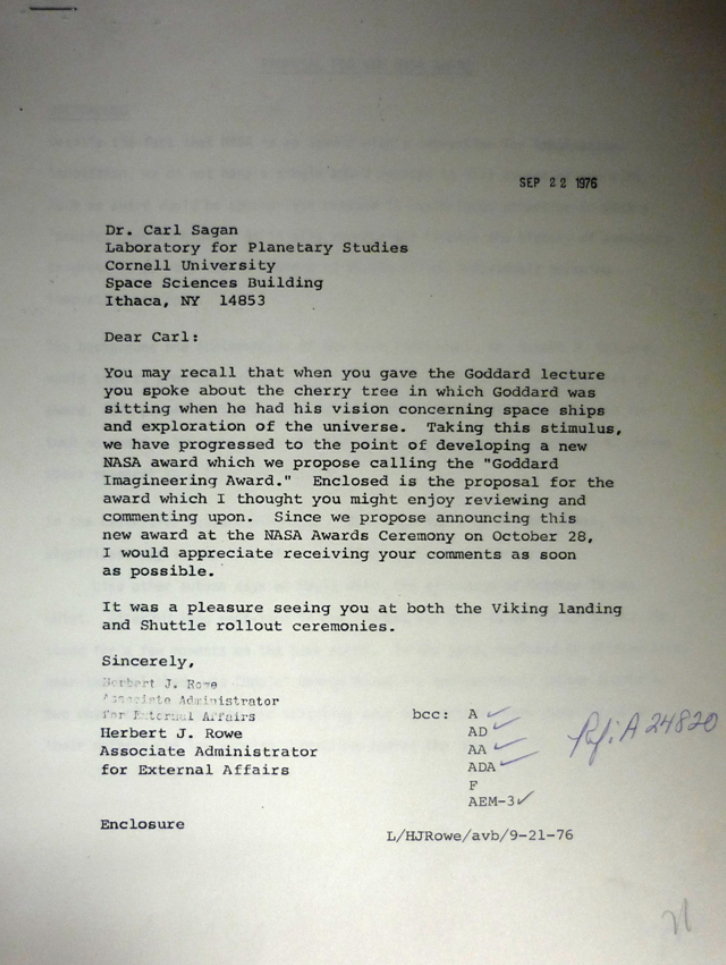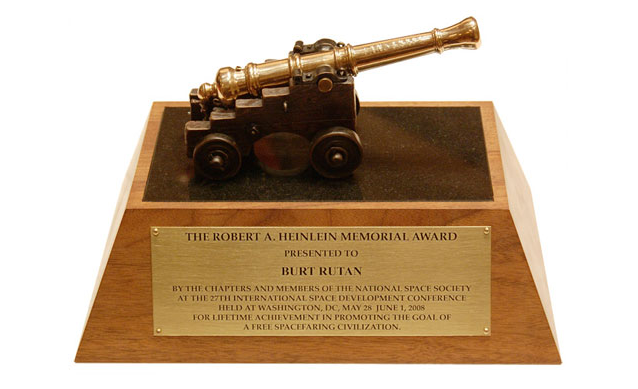"The Place They Do Imagineering"
 [Note: This is Part 2 of a two-part series; it follows up with a story I began in my last post. My thanks to Ray Macauley for sharing the documents referenced here.]After reading Carl Sagan's March 1976 essay, NASA head James Fletcher told the scientist he would try to find some way to commemorate Robert Goddard's Anniversary Day. About 5 months later, Herbert J. Rowe, an associate administrator for NASA's external affairs for NASA, told Sagan about a new award the space agency was planning. In his letter, Rowe included a proposal for the “Goddard Imagineering Award.”
[Note: This is Part 2 of a two-part series; it follows up with a story I began in my last post. My thanks to Ray Macauley for sharing the documents referenced here.]After reading Carl Sagan's March 1976 essay, NASA head James Fletcher told the scientist he would try to find some way to commemorate Robert Goddard's Anniversary Day. About 5 months later, Herbert J. Rowe, an associate administrator for NASA's external affairs for NASA, told Sagan about a new award the space agency was planning. In his letter, Rowe included a proposal for the “Goddard Imagineering Award.” Recipients of the new award would be “strong willed individuals pursuing innovative concepts.” It would favor the “past year’s most imaginative/innovative achievement in furthering the end objectives of the nation’s aerospace effort” and be open to contributions from people including “science, management, and engineering…They need not be from the aerospace community.” Besides the recognition, honorees would get $1,776 (the award would be initiated during the U.S.'s Bicentennial year.) The timing of the plan makes sense - the Apollo era was fading away and the space agency was keen to find its next big mission, especially in the realm of human spaceflight.There’s a short backstory here about "imagineers": In the histories of technology, there are individuals who have had a clear and strong vision of an expansive future created by technologies they studied, designed, and promoted. Pushing beyond hand-waving and podium speculations, their activities sometimes resulted in actual things like prototypes, models, patents, and computer simulations. Just as importantly, these people also built communities and networks so they could connect their ideas for the technological future to interested citizens, writers, politicians, and business leaders. Visioneer is the portmanteau I used to describe these people. But the term I originally wanted to use was “imagineer.”It sounds funny now – and I live in California which makes it that much more embarrassing – but I didn’t know this was a job category at the Walt Disney Corporation. Imagineers at Disney are the people who do the design and development of the company’s theme parks. My wife, a medievalist in possession of a better sense of pop culture than me, broke the bad news so I cast about for a different term. Hence, visioneer. In the end, it worked better.However, as it turns out, the folks at Disney weren’t the first to use “imagineering.” In February 1942, Time magazine carried an advertisement for Alcoa, the Pittsburgh-based aluminum company. Titled “The Place They Do Imagineering,” the ad’s text reads in part: “It takes a very special word to describe making aluminum cheap, making it versatile, finding totally new places to use it, and then helping people use it where they should…Imagineering is letting your imagination soar, and then engineering it down to earth.” Pretty close to what I meant by visioneers, in other words…
Recipients of the new award would be “strong willed individuals pursuing innovative concepts.” It would favor the “past year’s most imaginative/innovative achievement in furthering the end objectives of the nation’s aerospace effort” and be open to contributions from people including “science, management, and engineering…They need not be from the aerospace community.” Besides the recognition, honorees would get $1,776 (the award would be initiated during the U.S.'s Bicentennial year.) The timing of the plan makes sense - the Apollo era was fading away and the space agency was keen to find its next big mission, especially in the realm of human spaceflight.There’s a short backstory here about "imagineers": In the histories of technology, there are individuals who have had a clear and strong vision of an expansive future created by technologies they studied, designed, and promoted. Pushing beyond hand-waving and podium speculations, their activities sometimes resulted in actual things like prototypes, models, patents, and computer simulations. Just as importantly, these people also built communities and networks so they could connect their ideas for the technological future to interested citizens, writers, politicians, and business leaders. Visioneer is the portmanteau I used to describe these people. But the term I originally wanted to use was “imagineer.”It sounds funny now – and I live in California which makes it that much more embarrassing – but I didn’t know this was a job category at the Walt Disney Corporation. Imagineers at Disney are the people who do the design and development of the company’s theme parks. My wife, a medievalist in possession of a better sense of pop culture than me, broke the bad news so I cast about for a different term. Hence, visioneer. In the end, it worked better.However, as it turns out, the folks at Disney weren’t the first to use “imagineering.” In February 1942, Time magazine carried an advertisement for Alcoa, the Pittsburgh-based aluminum company. Titled “The Place They Do Imagineering,” the ad’s text reads in part: “It takes a very special word to describe making aluminum cheap, making it versatile, finding totally new places to use it, and then helping people use it where they should…Imagineering is letting your imagination soar, and then engineering it down to earth.” Pretty close to what I meant by visioneers, in other words… I haven’t yet located any more information on what Sagan said in response to Rowe. And, from what I can tell thus far, NASA's “imagineering” award itself never saw realization. Perhaps NASA didn’t want to tangle with Disney on this one. But...there are at least two awards now named after Goddard, including the Robert H. Goddard Memorial Trophy. This is given annually since 1958 by the National Space Club; this year it went to the Curiosity/Mars Science Laboratory team.I’d like to think that if NASA had actually instituted the "Goddard Imagineering Award", one of its early recipients might have been physicist Gerard O'Neill. Like Goddard, O'Neill had an expansive vision of how the humanization of space might be done and the long-term effects that space settlements might have. Like Goddard, O'Neill coupled his imagination to real-world engineering and design. As it turns out, in 1986 O'Neill did receive a somewhat similar award. This was named after a different Robert – science fiction author Robert A. Heinlein.
I haven’t yet located any more information on what Sagan said in response to Rowe. And, from what I can tell thus far, NASA's “imagineering” award itself never saw realization. Perhaps NASA didn’t want to tangle with Disney on this one. But...there are at least two awards now named after Goddard, including the Robert H. Goddard Memorial Trophy. This is given annually since 1958 by the National Space Club; this year it went to the Curiosity/Mars Science Laboratory team.I’d like to think that if NASA had actually instituted the "Goddard Imagineering Award", one of its early recipients might have been physicist Gerard O'Neill. Like Goddard, O'Neill had an expansive vision of how the humanization of space might be done and the long-term effects that space settlements might have. Like Goddard, O'Neill coupled his imagination to real-world engineering and design. As it turns out, in 1986 O'Neill did receive a somewhat similar award. This was named after a different Robert – science fiction author Robert A. Heinlein. O'Neill's trophy is still in the basement of his Princeton home but will soon be going to the National Air and Space Museum. But, more than anything, Rowe’s proposal is intriguing beyond his conceptualization of imagineering as a necessary ingredient in fostering innovative thinking. It makes me wonder what sorts of people might have received such an award. Open to people from outside NASA’s circle, perhaps the "Goddard Imagineering Award" might have gone to an artist, musician, or poet. Given that O'Neill, a physicist, eventually won an award named after a fiction writer, this would have made nice symmetry. One can only imagine.
O'Neill's trophy is still in the basement of his Princeton home but will soon be going to the National Air and Space Museum. But, more than anything, Rowe’s proposal is intriguing beyond his conceptualization of imagineering as a necessary ingredient in fostering innovative thinking. It makes me wonder what sorts of people might have received such an award. Open to people from outside NASA’s circle, perhaps the "Goddard Imagineering Award" might have gone to an artist, musician, or poet. Given that O'Neill, a physicist, eventually won an award named after a fiction writer, this would have made nice symmetry. One can only imagine.